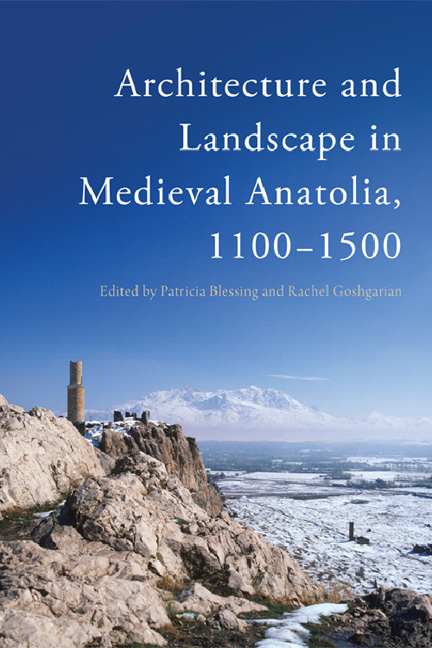Book contents
- Frontmatter
- Contents
- List of Illustrations and Tables
- Acknowledgements
- Foreword
- Map
- 1 Introduction – Space and Place: Applications to Medieval Anatolia
- Part I Building: Masons and Infrastructure
- Part II Social Groups: Akhis and Futuwwa
- Part III Exchange: Islamic and Christian Architecture
- Part IV Frameworks: Language, Geography and Identity
- 8 Harvesting Garden Semantics in Late Medieval Anatolia
- 9 All Quiet on the Eastern Frontier? The Contemporaries of Early Ottoman Architecture in Eastern Anatolia
- 10 The ‘Dual Identity’ of Mahperi Khatun: Piety, Patronage and Marriage across Frontiers in Seljuk Anatolia
- Notes on Contributors
- Bibliography
- Index
9 - All Quiet on the Eastern Frontier? The Contemporaries of Early Ottoman Architecture in Eastern Anatolia
from Part IV - Frameworks: Language, Geography and Identity
Published online by Cambridge University Press: 03 January 2018
- Frontmatter
- Contents
- List of Illustrations and Tables
- Acknowledgements
- Foreword
- Map
- 1 Introduction – Space and Place: Applications to Medieval Anatolia
- Part I Building: Masons and Infrastructure
- Part II Social Groups: Akhis and Futuwwa
- Part III Exchange: Islamic and Christian Architecture
- Part IV Frameworks: Language, Geography and Identity
- 8 Harvesting Garden Semantics in Late Medieval Anatolia
- 9 All Quiet on the Eastern Frontier? The Contemporaries of Early Ottoman Architecture in Eastern Anatolia
- 10 The ‘Dual Identity’ of Mahperi Khatun: Piety, Patronage and Marriage across Frontiers in Seljuk Anatolia
- Notes on Contributors
- Bibliography
- Index
Summary
Anatolian monuments built under the successor dynasties of the Ilkhanids in the mid-fourteenth to the mid-fifteenth century were close contemporaries to their early Ottoman counterparts. Patrons included the Eretnids, the Karamanids and the akhis in Ankara. In this post-Mongol context, architecture developed on a local scale, an element shared both by the principalities in eastern Anatolia and those to the west, including the Ottomans. The historiography of both Islamic and Ottoman architecture, however, presents these two sets of monuments in entirely different contexts. Early Ottoman architecture is shown as part of a linear narrative that leads directly from structures built in the late thirteenth century to the imperial mosques of Istanbul and Edirne conceived by master architect Sinan in the sixteenth century. Monuments in central and eastern Anatolia occupy a marginal existence within scholarship as provincial latecomers to what is constructed as an essentially Seljuk story, and for the most part have not been the object of detailed studies.
The same is true for the earliest period of Ottoman rule in the late thirteenth century; Ottoman architectural evidence from this time is extremely scarce and hence will not be the focus of this chapter. Rather, I will concentrate on several monuments in Ankara, Karaman, Kayseri, Konya and Sivas, built between the 1280s and the 1430s. The analysis of these monuments within their respective local contexts will elucidate the regional dynamics of patronage and construction in architecture in these areas after the fall of the Ilkhanid dynasty. A clearer understanding of this context will allow me to argue that the dynamics of local patronage and style were very similar in eastern and western Anatolia. For the latter region, scholars have argued that early Ottoman architecture was strongly rooted in the local – here, Byzantine – tradition of construction and that it was adapted to Ottoman needs and for the creation of an Ottoman visual identity. It will become clear from the present study that this approach to construction was not specific to Ottoman architecture, but that construction practices across Anatolia from the mid-thirteenth to the mid-fifteenth century were heavily reliant on local materials and styles in the absence of a unified imperial patronage.
- Type
- Chapter
- Information
- Architecture and Landscape in Medieval Anatolia, 1100-1500 , pp. 200 - 223Publisher: Edinburgh University PressPrint publication year: 2017

